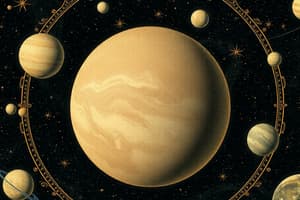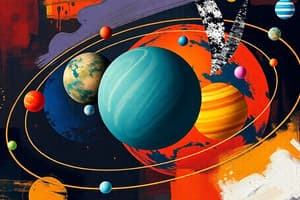Podcast
Questions and Answers
Which planet has the most moons?
Which planet has the most moons?
- Neptune
- Uranus
- Jupiter
- Saturn (correct)
What is the colour of Mars?
What is the colour of Mars?
- Red-orange (correct)
- Light blue
- Pale yellow
- Grey
Which of these planets does NOT have any moons?
Which of these planets does NOT have any moons?
- Mars
- Mercury (correct)
- Earth
- Venus
Which planet is described as 'small and rocky'?
Which planet is described as 'small and rocky'?
Which of these planets has poisonous yellow clouds?
Which of these planets has poisonous yellow clouds?
Which planet is 318 times bigger than Earth?
Which planet is 318 times bigger than Earth?
What is the name of Earth's moon, as used by astronomers?
What is the name of Earth's moon, as used by astronomers?
How many dwarf planets are there in the solar system (excluding Pluto)?
How many dwarf planets are there in the solar system (excluding Pluto)?
How long does it take Earth to orbit the Sun?
How long does it take Earth to orbit the Sun?
Flashcards
Mercury
Mercury
Smallest planet in the solar system, nearest to the Sun.
Earth
Earth
Only planet known to support life, light blue with clouds.
Mars
Mars
Rocky, red-orange planet, one of the driest, has two moons.
Saturn
Saturn
Signup and view all the flashcards
Jupiter
Jupiter
Signup and view all the flashcards
Neptune
Neptune
Signup and view all the flashcards
Venus
Venus
Signup and view all the flashcards
Orbit
Orbit
Signup and view all the flashcards
Dwarf planet
Dwarf planet
Signup and view all the flashcards
Study Notes
Planets in Our Solar System
- Mercury: Smallest planet, nearest to the Sun, grey and rocky, no moons.
- Earth: Supports life, light blue with white clouds, one moon.
- Mars: Red-orange, rocky, lifeless, two moons (Phobos and Deimos).
- Saturn: Pale yellow, thousands of bright rings, 53 known moons, beautiful.
Other Solar System Bodies
- Dwarf Planets: Three other dwarf planets also orbit the Sun.
- Pluto: Previously considered a planet, now classified as a dwarf planet due to its small size.
- Jupiter: 318 times bigger than Earth.
- Neptune: Fourth largest planet, strong winds (2000 km/hour).
- Venus: Poisonous yellow clouds.
- Moons: Some planets have moons, like Earth, Mars, & Saturn.
- Orbital Periods: Earth takes 12 months to orbit the Sun; the Moon orbits Earth in less than 28 days.
Additional Notes
- Planet Movement: Eight planets move around the Sun, with Mercury being closest.
- Ringed Planet: Saturn is famous for its rings.
- Solar System Structure: The Sun is at the center and planets orbit it.
Studying That Suits You
Use AI to generate personalized quizzes and flashcards to suit your learning preferences.




